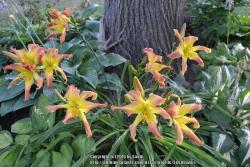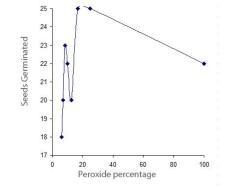sooby said:Interesting, Maurice, thanks for doing that.
You are welcome.
One thing I would suggest if someone can try this is to grow the seedlings on after germination to see if the stronger solutions are in any way detrimental.
Good idea; I agree.
The advantage I had with my tests is that the seeds were all from the same pod parent which I believe to be Hemerocallis lilioasphodelus, and were insect pollinated most likely with pollen also from the same daylily because no other daylilies were flowering in the vicinity that early. There's more likely to be a mix of parentages and ploidies in most peoples' seeds, is it necessary to design the experiment around that and, if so, what would you suggest?
25 seeds per dilution is a good number; more is better. I would suggest that 20 seeds is the minimum per dilution.
It is best and simpler if all the seeds used come from the same pod parent; The same pollen parent is not necessary as long as all the seeds for the test are mixed in one batch and selected at random for each dilution. Best if the same number of seeds is tested at each dilution.
What is absolutely important is that the seeds tested at each dilution are similar; have no known differences. Some examples below:
You have 100 seeds from cross of A x B and you are going to test 5 dilutions - then choose 20 seeds at random (e.g. with eyes closed) from the pile of seeds for each dilution.
You have 20 seeds from A x B, 40 seeds from D x S and 60 seeds from J x G - total number of seeds is 120. You are going to test five dilutions then choose 24 seeds for each dilution. Choose 4 seeds from cross A x B, 8 seeds from cross D x S and 12 seeds from cross J x G for each dilution. The 4, 8, and 12 seeds from the different crosses can be combined. Not quite as good but also acceptable is to combine the 20 AxB seeds, the 40 DxS seeds and the 60 JxG seeds in one container with a lid and mix them
very thoroughly. Then choose 24 seeds at a time from the container for each peroxide dilution.
If seeds from different crosses need to be mixed then it is important to keep the number of seeds used from each cross a multiple of the number of dilutions being tested. So if we are going to test five dilutions then the number of seeds from each cross should be 5 or 10 or 15 or 20 or 25, etc. If we are going to test 6 dilutions then the number of seeds from each cross should be 6 or 12 or 18 or 24, etc. That way each dilution has a good chance of getting the same number of seeds from each cross. If we used 3 seeds from one cross and 7 seven seeds from another cross and five dilutions then two of the dilutions would not get a seed from the first cross and probably three of the dilutions would get one seed from the second cross while two of the dilutions would get two seeds from that cross.
The important thing is to make certain each dilution receives seeds that are as similar as possible.

